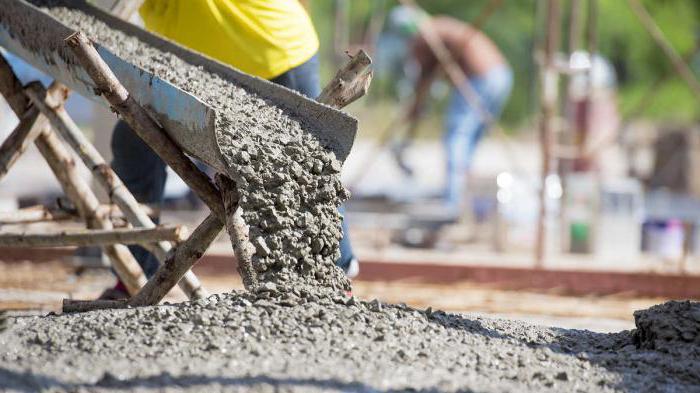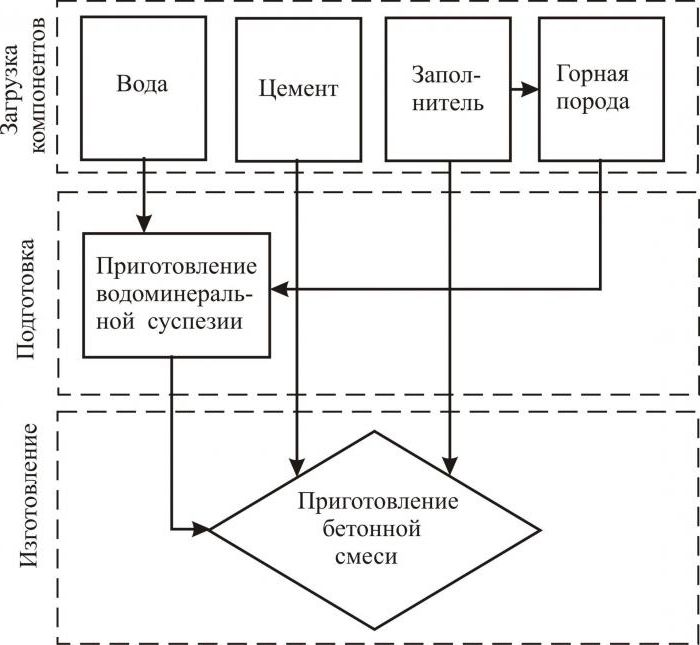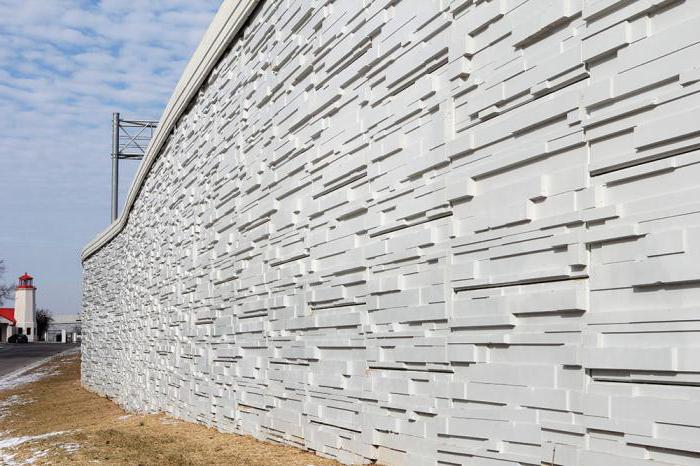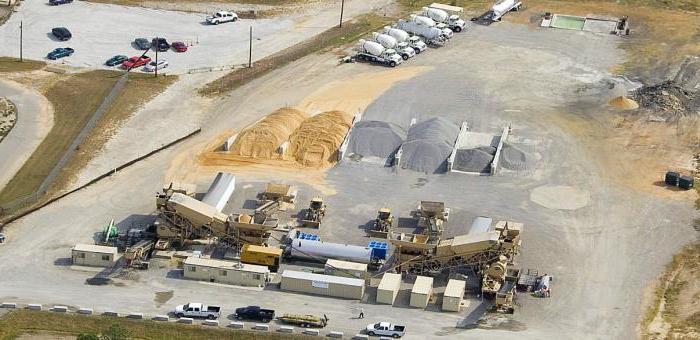Concrete is a leading material in construction and, according to scientists, will remain so for at least another 40-60 years. At the same time, the technology of concrete production over the past half century has changed little. Although the manufacturing process is time-consuming, the equipment used is structurally quite simple and inexpensive. This allows you to arrange the production of popular building material without high costs.

History reference
The technology of concrete production was known even to the ancient Sumerians, who widely used it 4000-5000 years ago. Later technology was adopted by the Babylonians, Egyptians and other civilizations. Recently, in Serbia, they discovered a building aged 7600 years, the floor of which is poured with a 25-cm layer of concrete based on limestone. The ancient building material, of course, differs from the modern one, but the principle remains the same: the binding material through the action of water fastens the ballast filler (sand, stones, straw). After drying, the mixture becomes very strong.
After millennia, the ancient Romans perfected technology. They found that in abundance the volcanic material contained on the Apennines (tuff, pumice, ash) in combination with water, sand, gravel after tamping and drying becomes as strong as stone. In the Roman Empire, public institutions, aqueducts, sewers, and private houses were massively built from concrete. Until now, the largest building, the dome of which is entirely made of unreinforced concrete, remains the Pantheon, erected by the Romans many centuries ago. To some extent, the Great Wall of China also resembles a concrete structure.
After the fall of Rome, in the Middle Ages, technology was lost. Only in the XVII-XVIII centuries began attempts to revive the forgotten secrets of the ancient builders. James Parker in 1796 patented a recipe for the manufacture of "Roman cement" based on pozzolans. In parallel, scientists were looking for alternative binders that could replace volcanic materials.
An important contribution was made by the French bridge engineer Louis Vic. He found that a mixture of limestone and clay produces an effective binder. In 1828 he built a bridge using cement, and in 1840 he presented to the public a revised material - Portland cement, which is still widely used today.

Description
Concrete is a common artificial building material, when solidified, it takes a stone-like shape. Various methods for producing concrete are known, but most of them come down to mixing in certain proportions a binder (usually cement), aggregate (sand, gravel, buta, etc.) and water. To improve the quality of the mixture, various additives can be used: water repellents, plasticizers and others. In the manufacture of asphalt concrete, bitumen is used instead of water.
Composition
Although there are not many concrete components, there are thousands of brands in the world that differ in the percentage of materials and the additives used. The classic composition of concrete is as follows:
- cement;
- sand;
- aggregate (gravel, crushed stone, pebbles, expanded clay, etc.);
- water;
- additives (optional).
The percentage of these components depends on the required concrete grade, cement characteristics, moisture coefficient of the sand-gravel mixture, and the properties of the additives. Recommended proportions when using cement M500 are presented in the table.
Concrete grade | Cement, kg / parts | Sand, kg / parts | Crushed stone, kg / parts |
200 | 1 | 3,5 | 5,6 |
250 | 1 | 2,6 | 4,5 |
300 | 1 | 2,4 | 4,3 |
400 | 1 | 1,6 | 3,2 |
450 | 1 | 1,4 | 2,9 |
The most important factor is the amount of water. Usually it is 0.5-1 part, however, it should be calculated based on the moisture content of the mixture, the desired strength, degree of fluidity, setting time, additives used. The coefficient of water-cement ratio should ideally be 0.3-0.5. With an excess of water, the strength of the finished cement decreases.

Production of concrete additives
One of the strategic directions in the development of concrete technology is the use of additives. There are about 50 types of them used in the world, with more than 50,000 brands. Each substance (even chicken eggs and urea) can be considered as additives to concrete and mortars. To improve the composition of concrete, scientists are developing multifunctional additives that cause a synergistic effect.
At the end of the 20th century, superplasticizers were invented and introduced - multicomponent universal additives that have plasticizing and water-reducing properties. This allowed the construction to switch to the mass use of highly mobile, cast concrete mixes and high-strength concrete with compressive strength up to 80 MPa and up to 4 MPa in tension.

Concrete compaction
The technology for the production of concrete on an industrial scale includes the stage of compaction of concrete mixtures. As a rule, this is done through vibration, during which microscopic voids are filled. Also quite common is the centrifugal (vibration-free) method of forming reinforced concrete products, especially when processing concrete for the manufacture of pressureless pipes.
Vibration compaction
The production process of high-quality concrete, as a rule, implies the use of vibration plants in the future. The most widespread type of vibration formation is bench (easel) vibration compaction. In this case, the molds with the concrete mixture are installed on the vibrating platform, which is subject to vibrations from the vibrating mechanism.
Vibration platforms of various types are used for bench vibration, this is the technological features of the method. They are classified by the layout of the table and the vibrating organ, load capacity and the main parameters of vibration. The layout distinguishes:
- mechanisms having one table with a vibration exciter located below;
- block-type vibration platforms, consisting of unified blocks with one vibration exciter located under the table of one of the blocks.
The capacity of the sites is determined by the power of the drive motors. The most common vibration platforms with a carrying capacity of 3, 5, 7, 10 and 15 tons, less often - 20 and 25 tons. The carrying capacity of block mechanisms is in the range of 2-24 tons.

Vibrating technology
The most complex technology for the production of concrete is vibro-vacuum mixtures. It is characterized by a combination of periodic evacuation with vibration. Vibrations are carried out for laying and compacting the concrete mixture. In the process of evacuation, the vibration is turned on for a sufficiently short time in order to localize the friction between the particles of the mixture, to contribute to a better filling of the gas-vapor space.
The magnitude of the vacuum vacuum is 75-80% of the absolute value. As a result, a pressure gradient is formed, under the influence of which excessive water, air and steam-air mixture are sent from atmospheric pressure zones to vacuum sources and removed from concrete.
Vibrocompression is used to form many products, in particular for the production of paving slabs and road elements, in the manufacture of pressure head reinforced concrete pipes and other products from rigid, mainly fine-grained mixtures.
Centrifugal compaction method
The essence of centrifugal formation is that when the formatter is rotated with a uniformly distributed layer of concrete mixture, centrifugal pressure arises, under the influence of which the separation of the parts of the solid phase in size and their rapprochement takes place, accompanied by the displacement of water with suspended dissociated ions and highly dispersed fractions of cement.
To eliminate structural and textural heterogeneity, which reduces the strength of concrete, a method for layer-by-layer compaction of concrete mixture is proposed. Thanks to this method, a homogeneous concrete texture is formed over the entire section of the product wall. In order to increase the physicomechanical properties of centrifuged concrete, repeated centrifugation is applied after loosening the compacted mixture.

Equipment
Equipment for concrete production varies widely: from simple hand-held concrete mixers to industrial multi-level complexes. For private construction it is convenient to use small mechanized (electric, diesel) concrete mixers. Their cost starts from 5-6 thousand rubles. Component loading is done manually. Significant disadvantages are the complexity of the exact dosage of the added materials, the lack of mechanisms for compaction of the mixture, low productivity.
If the goal is to organize a small private enterprise, then the best option would be a mobile concrete plant. Equipment for a mini-factory is relatively inexpensive - from 400 thousand rubles, which is cheaper than a car. Moreover, the profitability of the enterprise can reach 1 million rubles per month.
Automated lines with a powerful installation for mixing components, a vibrating system, and conveyor loading of material into a concrete truck are more expensive. At a cost of 1.5 million rubles, they demonstrate excellent performance to provide concrete to private clients and small construction firms.

Industrial production
Features of concrete production at specialized enterprises are the use of powerful multi-level equipment, vibrating, vibrating or centrifugal plants, various additives, plasticizers. Not only concrete is made here, but also its final products - from paving slabs, curbs and sewer rings to staircases, prefabricated structures for panel house building, elements of bridges and industrial structures.
In large enterprises, the quantity and quality of components is calculated in factory laboratories up to tenths of a percent. Professional equipment allows you to use the minimum allowable amount of water, which significantly improves the quality of the finished material, and the use of additives increases the setting time and the degree of fluidity of concrete. Concrete mixing plants stir the mixture to a homogeneous mass with a quality unattainable for cheap concrete mixers.